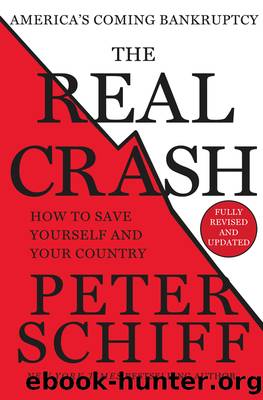The Real Crash by Peter D. Schiff

Author:Peter D. Schiff
Language: eng
Format: epub
Publisher: St. Martin's Publishing Group
The Scheme Is Crumbling
What made Ponziâs scheme fall apart? The public figuring out that there was nothing there.
And when did Madoffâs house of cards collapse? It was when investors started calling on their money.
The point at which Ponzi and Madoff and dozens like them finally were exposed, and thus crumbledâthatâs where Social Security is now.
The idea of Social Security as a self-funding, reliable source of retirement security is a joke. Social Security taxes no longer cover Social Security benefits. In 2011, benefits were expected to be $733 billion, while taxes were estimated at $637 billion.3 How did Congress react to this imbalance? By reducing Social Security taxes, and thus widening the deficit.
As part of the late 2010 tax-extenders deal, Congress passed a temporary cut in the Social Security tax. Republicans liked it because it was a tax cut. Democrats liked it because it was a rare tax cut that could benefit the lower middle class (many of whom donât pay income taxes).
This tipped the scale, sending Social Security into a deficit from which it will never emerge. For every year from now until the end of time, Social Security is projected to pay out more than it takes inâeven if the temporary tax cut is ended.
Things are just going to get worse for this program.
As unemployment continues to grow (and it will), there are fewer workers paying in. With jobs hard to find and wages stagnant, people are retiring earlier than they otherwise would.
Demographics are also driving Social Security toward insolvency. After World War II, America enjoyed a Baby Boom, but those Baby Boomers didnât have as many kids. The result, as the Social Security Administration puts it: âAfter 2014, cash deficits are expected to grow rapidly as the number of beneficiaries continues to grow at a substantially faster rate than the number of covered workers.â
In 1950, there were 35 million workers paying Social Security taxes and 222,000 retirees collecting itâa 159.4 to 1 ratio.4 That eventually stabilized by 1975, at about 3.2 workers to every retiree. Now, with Baby Boomers retiring and job growth near zero, that ratio has begun plummeting.
In 2010, the number of beneficiaries (roughly equal to new retirees minus deaths) grew by 1.5 million, while the number of workers grew by 700,000. From 2000 to 2010, the number of recipients grew by 18.2 percent, while the number of payers grew by less than one percent.
This trend is only going to accelerate. By 2031, SSA forecasts there will be one Social Security retiree for every 2.1 workers.
This is unsustainable.
Download
This site does not store any files on its server. We only index and link to content provided by other sites. Please contact the content providers to delete copyright contents if any and email us, we'll remove relevant links or contents immediately.
The Secret History by Donna Tartt(18062)
The Social Justice Warrior Handbook by Lisa De Pasquale(11932)
Thirteen Reasons Why by Jay Asher(8401)
This Is How You Lose Her by Junot Diaz(6403)
Weapons of Math Destruction by Cathy O'Neil(5784)
Zero to One by Peter Thiel(5450)
Beartown by Fredrik Backman(5295)
The Myth of the Strong Leader by Archie Brown(5206)
The Fire Next Time by James Baldwin(4993)
How Democracies Die by Steven Levitsky & Daniel Ziblatt(4935)
Promise Me, Dad by Joe Biden(4893)
Stone's Rules by Roger Stone(4822)
100 Deadly Skills by Clint Emerson(4650)
Rise and Kill First by Ronen Bergman(4530)
A Higher Loyalty: Truth, Lies, and Leadership by James Comey(4523)
The David Icke Guide to the Global Conspiracy (and how to end it) by David Icke(4351)
Secrecy World by Jake Bernstein(4346)
The Farm by Tom Rob Smith(4296)
The Doomsday Machine by Daniel Ellsberg(4224)
